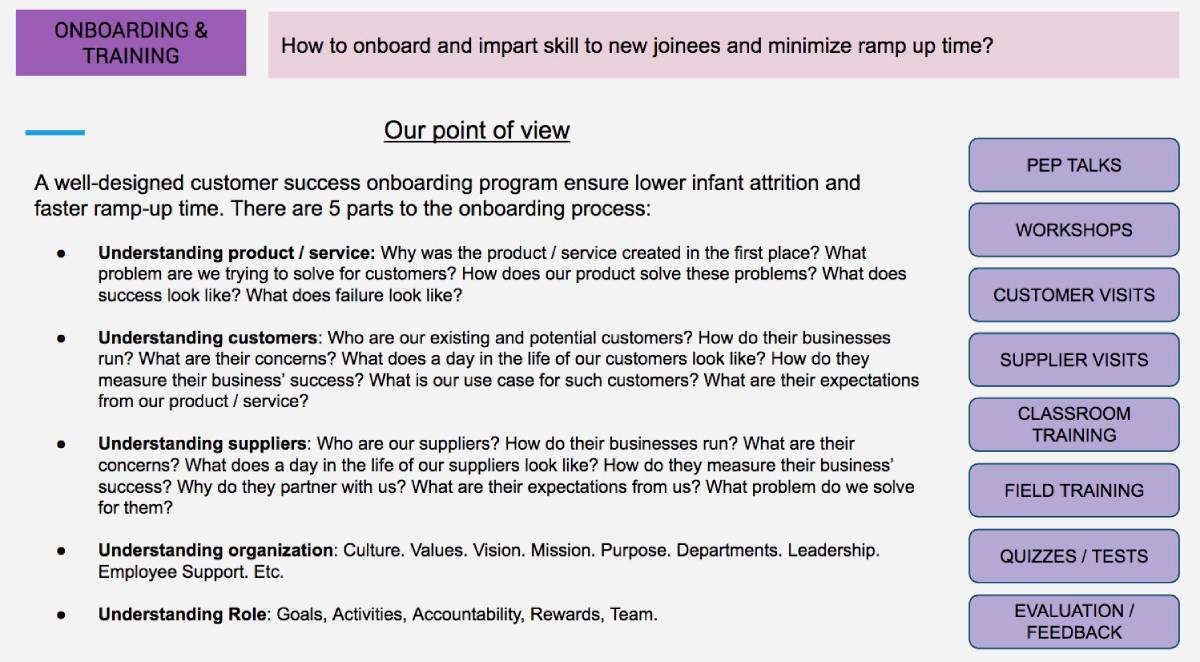
Context: We started working on sales design related stuff 3 years ago. Since then, we’ve met ~ 200 CEOs / COOs / VP Sales of early and mid-stage companies to understand their go-to-market challenges. Most of these companies are backed up by reputed investors so we’re talking about serious bets on the future here. As we reflect back, we see clear patterns in those challenges and thought of sharing them in this post.
CEO persona: Let us paint a picture of the most common persona we met. Think of this CEO / COO / Sales Leader as a young (25–35 yr), ambitious person who is the brains behind the concept and the product but doesn’t necessarily code. She has a co-founder in the same age bracket who usually looks after sales. Both have worked in one organization before they founded the company and none of them has worked in sales before. The CEO has bootstrapped her way through the initial phase and then picked up some funding. Her network within the investor community is quite good. She’s aware of pretty much every book start-up CEOs are advised to read by pundits — most of them around product development and leadership. While she’s looking after one function for ~ 40% of her time, she wishes she had more hands to take care of all the stuff thrown at her by sales, marketing, finance, HR, admin and those endless requests for “2 min chats” with any team member not happy with something.
Business Model: Mostly aggregators, SaaS, media with modern, digital products. Most of them selling on a subscription model.
Sales Model: Mostly B2B, few B2C. Mostly selling to SMEs. Another chunk to large enterprises.
Stuff we hear from them
- “Something’s off about sales but I don’t quite know what it is.”
- “My actual vs forecasted sales is out of whack.”
- “Our sales processes are broken.”
- “I don’t know how our future org structure should look.”
- “Our sales are too rainmaker dependent.”
- “Our hires look brilliant in the interview but don’t know what’s wrong with them now.”
- “Should I hire freshers or experienced salespeople?”
- “Our people make the sale but don’t service the client well. They just land up for renewal.”
- “I don’t know how I should price my product.”
- “Our reps need sales training but we just can’t seem to find the time.”
- “I suspect my sales reps aren’t calling/meeting as many prospects as they should.”
- “Some of our cities are performing well but others aren’t.”
- “It’s really difficult to manage branch offices.”
- “I don’t know how to gauge my VP Sales’ performance.”
Phew. That’s a lot. Any of this sounds familiar? If yes, read on.
Our response: Once we heard these, we normally try to understand 3 things — their product, their customers and their revenue statement. And here are our version of the execution challenges we found
This is the second part of a three part series. We cover what we heard about customer success, Sales Hiring & Onboarding. You can read part 1 here
Customer Success
Most of these companies didn’t have a customer success set-up. The ones that did, weren’t functioning too scientifically. Churn had not shown its ugly face in most of these companies so the need wasn’t felt. But we did our duty by issuing a forewarning.
Example: Churn prediction is still not a scientific exercise in these companies. Product usage and engagement metrics aren’t being measured for every account. Which basically means that they have little or no data-driven point of view on whether the product is working well for the customer or not.
Hiring
“There’s a huge lack of quality talent for sales roles in India”. We empathise and couldn’t agree more. We face similar constraints ourselves. When we looked deeper into these companies, we found very high rejection rates in the recruiter round. And when we asked the recruiter why they rejected the candidates they did, here’s what we got
“They didn’t clear the Group Discussion round. Just didn’t speak anything.”
As compared to Group Discussions, far better and more scientific methods of screening are now available out there.
“We asked them behavioural and resume-based questions and weren’t satisfied with the quality of replies.”
“A lot of them came across as arrogant”
We further asked them what questions they asked the candidate, what were they looking for in the reply and what inference about their competence they would make based on that reply. I am planning to write another post on the nature of answers we got from the recruiters. But here’s the gist: most recruiters did not have any specific competency list they were checking in the candidate let alone a scientific methodology to check them. They were purely relying on their “recruiter’s gut feel” to gauge the candidates. “Recruiter’s gut feel” is the biggest self-imposed constraint in sales hiring today. When applied in isolation, it just makes matters worse while scaling up. We also observed that inexperienced recruiters find it very difficult to deal with the assertiveness exhibited by typical sales personalities.
On an average, we came to know that 4 out of 5 candidates were not making it beyond the recruiter’s round in these companies. When we connect this piece of information with our observation about the current recruitment methodology (or lack of it), we are convinced that better methods need to be adopted.
The second problem we found in hiring was a classic agency problem with hiring managers. The hiring managers would gladly take safe calls of rejecting candidates at the slightest hint of lack of fit. Who wants to own the hire if they don’t work out later? What will be boss’ reaction? Will I be labelled a poor hiring manager? When we looked further, none of the hiring managers had significant hiring experience in the past. Upon quizzing them, we again found a lack of methodology and competency list that they were looking to check.
In our opinion, every candidate at the top of the funnel should be administered a sales assessment test (example) before the interview rounds. Also, interviews should be designed in a pre-determined way with a clear list of conversational themes.
Onboarding
The trend in the current method of Onboarding can be summarised in one sentence: “A few sessions with HR and leadership of the company and then shadow the masters on the field.”
Though this seems like a fair process, we’ve usually seen a big downside of this as the company scales. Only selective, tribal knowledge gets passed on to sales reps in this method. Such knowledge is necessary but not sufficient to ensure the sales rep’s success.
We later designed the Onboarding program for few of these companies. Here’s an example:

In the final part of this series we’ll cover things we heard about goal setting, sales training and messaging.

If you need our help in Sales Development, please write back to me at saurabh@salesdesign.co.in
For more information B2B Lead Generation Get in touch



